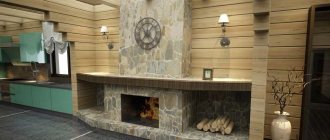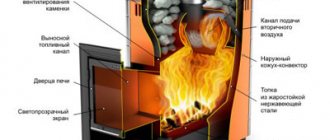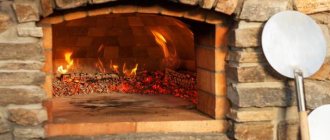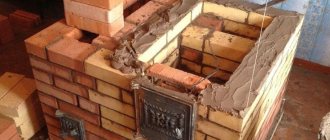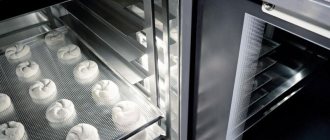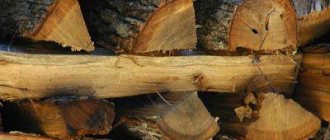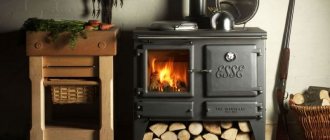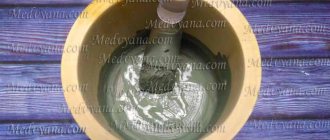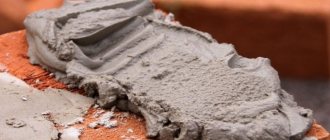Why are stoves and fireplaces painted?
By painting fireplace heating devices, the following problems can be solved:
- Protect the surface from household pollution, and clothing from traces of brick dust.
- Simplify your daily care process. Paint allows you to achieve an attractive appearance of the treated surface and maintain its cleanliness without the use of special detergents - just wipe it with a damp cloth.
- Improve the decorative qualities of the fireplace and stove in the room.
- Design the heating device in accordance with the existing interior.
- Prevent the appearance of cracks in the brick and an increase in the size of existing defects. By using heat-resistant paint, it is possible to achieve a smooth surface.
- Improve heat transfer.
Properly selected paint makes it possible to hide defects and improve the aesthetics of a fireplace or stove
Requirements for stove paints
Any paint composition used must withstand high temperature conditions - this is the main indicator by which the choice should be made.
Important! Considering the difference in heating temperatures between a metal heating device and a fireplace or brick stove, you need to select paint in accordance with the unit used. It is not effective to use the same paint composition for an iron and brick stove.
Depending on the degree of resistance to high temperatures, the paint can be:
- Fireproof. It is best used for painting metal devices to create a reliable coating against corrosive changes and the effects of aggressive combustion products. It must withstand temperatures of 1800 °C. The only disadvantage of this paint is its high cost.
- Heat resistant. This composition can be used to protect metal parts of the fireplace, stove, as well as the steel body of the heater. Operating temperature varies between 600-1000 °C. But for painting stone elements of stoves and chimneys, paints that can withstand temperatures in the range of 200-400 °C are suitable. For these purposes, varnishes with a heat resistance of 250-450 °C are suitable.
Fire retardant compounds and high-temperature paints for stoves and fireplaces with a similar name have completely different purposes - the former are needed for treating surfaces against fire from the outside.
In addition to the level of resistance to elevated temperatures, the paint composition must meet the following requirements:
- Safety, since when heated, substances harmful to human health may be released.
- With sufficient thermal conductivity - there should be no obstacles to heat exchange between the surface of the fireplace, stove and the air in the room.
- Resistant to chemical compounds. Neither the appearance of the painted surface nor the physical properties of the composition should be lost during the heating process.
- Elasticity. During operation, the paint composition should not crack. Often, if the paint is chosen incorrectly and under conditions of temperature changes, the painted surface begins to crack, peel, and peel.
- With a high level of saturation, even after applying three layers, the coating should be uniform.
PAINT FOR STOVES
Anyone who is puzzled by the question of how to paint a stove has one of two goals: to hide uneven masonry or the less than ideal quality of the brick itself, or to “fit” the stove itself into the design of the room where it is located.
Photo: How to paint a stove
And if one can argue with the necessity of the second option (since ancient times, people tried in every conceivable and inconceivable way to leave the texture of brickwork on display), then how to paint a brick stove , if its appearance is far from ideal, turned from a whim into a necessity. However, if you did not do the masonry yourself, but invited a master stove maker, then you listened, and often unquestioningly followed his advice on how to paint the stove .
But if you did all the work yourself, here are some tips:
- Take your time with the final painting. Let what you use to paint the brick stove remain in the jar for now, and you let not only the solution dry, but also the bricks themselves. Better yet, heat the stove well the first time, and then paint it.
Photo: How to paint a stove
Soberly evaluate what is more important, the functionality of the stove or its aesthetics.
Its thermal conductivity depends on the paint, so it is better not to paint a brick stove in a dacha , but to whitewash it, as this has been done since ancient times. And to obtain the desired color or shade, add color or just gouache to the composition and mix thoroughly. But remember that over time, due to constant temperature changes, the whitewash itself will darken and fade a little, so if you are not going to refresh it every three months, choose a brighter and more saturated color.- Choosing what to paint a stove with is actually not much different from ordinary paint. Oil, enamel or all kinds of synthetic compounds (pentaphthalic, nitro and others) or even latex paints. There is only one condition: they must be heat-resistant, and you will find a mention of this on the packaging. But oil paints, for the preparation of which natural drying oil was used, will darken very quickly, especially in particularly hot places, and latex paints have a very meager palette.
- If you want the stove to be functional first and then attractive, do not choose to paint the stove in your house . Not only do smoother surfaces transfer heat worse (compared to rough ones), but all kinds of “metals” cut off heat significantly. And this, in addition to the lower efficiency of the furnace, leads to even greater heating and expansion of the stone, and hence to its cracking. It’s a shame when after a month the entire oven is covered with a small “web” of cracks.
But before you paint the stove, it needs to be given a “marketable appearance.” And putty from the same composition that was used for the masonry is the simplest option.
Oven tiling
Photo: How to paint a stove
Types of paints for fireplaces and stoves
Paint for brick stoves and fireplaces is available on the market in a huge range, in different volumes, from many manufacturers. A wide selection allows the consumer to buy the most suitable option if they need to achieve the same shade as the interior, or maintain the natural appearance of the masonry. For plastered heating devices, paints of a slightly different type are used.
Organosilicon compounds
The basis of these high quality mixtures is organic resin. Among the advantages of the material are noted:
- sufficient degree of adhesion to the surface of any texture;
- creation of a durable protective layer;
- moisture resistance;
- long service life;
- increased level of heat resistance;
- elasticity.
Organosilicon paint can withstand both moisture and the sun.
The disadvantages include limited color options. To paint a brick fireplace or stove, it is enough to use a roller or brush, but for greater efficiency and convenience, use a spray gun. Before application, the surface must be thoroughly prepared, cleaned and treated with a deep penetration primer.
Heat resistant paint
Heat-resistant paint for brick fireplaces is made either water-based or hydrocarbon-based. Both types have proven themselves exclusively on the positive side; the coating is uniform and practical. But the greatest demand is for water-dispersed compositions, characterized by their ability to withstand temperatures of 200-400 °C.
Heat-resistant paints do not emit substances harmful to humans when heated; they are completely safe
The presence of a durable film coating on the surface of the heating device is explained by the ability of heat-resistant paint to penetrate deep into the pores. It is best if applied with a brush or roller in two passes. The color palette is huge; if necessary, you can add color, then the coating will have a more pronounced effect.
Alkyd emulsions
Among the components of such a paint composition are alkyd varnishes and solvents (white spirit). Depending on the type of emulsion, it may contain marble or granite dust, as well as antifungal components and anti-fire additives.
To increase the strength of the coating, turpentine is added to the paint in equal proportions.
An alkyd composition is used to decorate surfaces that will be operated at temperatures not exceeding 100 °C. The main advantage of the paint is the variety of shades, but in terms of elasticity it is somewhat inferior to the acrylic composition. This affects the appearance of the fireplace and stove - cracks form that need to be repaired.
Furnace finishing by painting.
Today, it is customary to use the following technologies for finishing lined stoves and fireplaces:
- surface painting;
- special decorative jointing of masonry joints;
- plastering;
- metal cladding;
- cladding with decorative ceramics, ceramic tiles or stone (natural and artificial);
- cladding using tiles.
In this article we will look at the technology for painting the surface of a finished stove.
When deciding that the finishing of the finished structure will be carried out as follows, it is necessary to understand that painting the stove can only be done with special heat-resistant paints.
The undoubted advantage of this finishing option is its simplicity, cost-effectiveness and sufficient durability of the applied coating.
The technology of applying paint to the walls of the finished furnace has a number of specific features. It should be taken into account that the formulation of modern synthetic paints contains quite a lot of different components that change their color under the influence of high temperatures. In addition, not all paints can be mixed in order to obtain the required colors.
Benzene, gasoline, various alcohols, acetone and turpentine are most often used as solvents for currently produced paints.
When performing coloring, you should use a minimum amount of substances that act as a binder, which include oils. The latter begin to evaporate or decompose under the influence of high temperatures.
We recommend using a mixture of the following composition to prepare the paint that is planned to be used for finishing the stove (the components are given in parts by weight): paint – turpentine – varnish – 30:30:40.
Be sure to pay attention to the fact that all paints you use, materials used as a binder, and mixtures of the above components must be heat-resistant. Professional stove makers recommend the paints listed below:
if you need a white color, then stop your attention on zinc or titanium white. Limestone and chalk are excellent for these purposes;- The red-yellow color of your structure will be given by chrome-orange or burnt yellow paint;
- The pure red color of the furnace can be given by using red lead and any fired iron oxides for this purpose;
- You can get a green color by using a green cobalt compound or chromium oxide for these purposes;
- blue color can be obtained by using ultramarine or cobalt;
- classic black color will be ensured by the use of graphite or charcoal (option: bone charcoal);
- The finished structure can be given a bronze color using aluminum bronze.
It is important to remember that only dry surfaces can be painted. If the coloring agent you apply does not adhere well to the surface of the oven, then you should paint in two or three layers. Moreover, we strive to ensure that the thickness of the applied layer is minimal. The next layer is applied only after the previous one has completely dried. Paints are applied with a spray gun, roller or brush.
If asbestos plywood (polished gray) is used in the design, it can be painted with aluminum powder (powder) by preparing a mixture of the following components (the quantitative composition is given by weight): gasoline - aluminum powder - varnish No. 177 (asphalt) - 10:20:70.
Asbestos-cement facing sheets are painted with enamels of the following brands: EP-140, AS-131, KO-081, EP-274, KO-0822, etc. For enamel paint, the specified surface must first be treated with a special heat-resistant compound: silicone or epoxy. These compounds can withstand temperatures of 150-200 degrees for a long time. After applying this composition, the sheet dries for about two hours (at room temperature), then it is processed with sandpaper. The specified layer is applied at least three times. And the enamel coating on top of it is at least two. Moreover, it is recommended to apply the final layer to a surface preheated to 120 degrees.
It is possible to paint the stove with lime paints. The solution has the following composition: table salt - 100 grams, wood glue - 250 grams, water - 1 liter.
Pour a bucket of water into 2.5 kilograms of lime dough, continuously stirring the resulting mass. Add a solution of glue, salt and drying oil (50 grams) to it. The resulting consistency is thoroughly mixed and then filtered. The resulting composition can be used to paint the structure white, or use it as a primer. Various colors are obtained by using dry pigments added to the composition described above: ocher, blancfix, red lead, ultramarine, etc. The selected design is applied to the primed surface of the stove with an airbrush or brush. The option of applying it through a stencil or making it with colored bricks is possible.
The doors of the ash chamber and firebox are usually painted with black paint based on organosilicon compounds. This paint can be used to paint all metal structural elements of your heating device.
What paint is best to paint a brick fireplace?
The use of conventional paints and varnishes for the practical and beautiful design of fireplaces and stoves is not suitable, given the strong heating of the surface. This will require a special heat-resistant composition, which contains components that can withstand extremely high temperatures. Thus, the ability of fire-resistant paint without loss of performance is visible even at 650 °C. This indicator is quite enough to withstand the combustion temperature of firewood at 300 °C.
Important! To paint metal heating structures, the operating temperature of the composition used must be greater than 600 °C.
When choosing heat-resistant paint, you should pay attention to its application features; it should be a paint and varnish material for indoor work. If the heating device is contained in a bathhouse, the paint must have a high degree of resistance to high humidity. Preference should be given to enamels that can withstand heating at 800-1000 °C. Surfaces exposed to high heat must be treated with heat-resistant, heat-resistant or fire-resistant compounds.
To obtain a glossy shine on a fireplace or stove, heat-resistant varnishes are used, characterized by their ability to withstand temperatures of 300 °C
Preferred Brands
The market for modern finishing and paintwork materials is quite wide, and in order to choose the right coating suitable for fireplaces and stoves, you need to take into account many nuances.
The most famous and popular varnishes that can be used to coat a brick oven are: KO-85, KO-815 and Siltek-1. The presented materials have long held leading positions in their segments and have many advantages.
- KO-85. First of all, a store consultant will always recommend heat-resistant varnish KO-85. It can be used not only at the household level, but also to cover the surfaces of industrial equipment. A characteristic feature of the material is that it can easily withstand temperatures of 300°C degrees. Moreover, the unique composition can easily tolerate temperature fluctuations in a brick oven, even if the thermometer needle drops below -30°C degrees. Another nuance is the possibility of applying varnish using a spray bottle, which speeds up the surface treatment process, and the consistency of the liquid itself can be adjusted when diluted.
Varnish label KO-85
- KO-815. When using heat-resistant varnish KO-815, you don’t have to worry if temperature changes from 60 to 300°C are observed on the stove. Thanks to the high-quality composition, the coating is applied perfectly and is not overused, which allows you to significantly save on the purchase of material. Moreover, the presented coating can be safely used for application to those fireplace surfaces that have direct contact with the flame. The only inconvenience is that you can only work with varnish using the hot method. This means that hardening of the surface will occur only under certain conditions, which include heating the surface with infrared radiation.
Heat-resistant composition KO-815
- Siltek-1. The material called Siltek-1 allows the master to work with the surface of the furnace without first covering it with a special primer solution. Although in this case it is worth considering that when obtaining a fairly aesthetic result, a lot of material is consumed. The fact is that in order for the stove luggage to look beautiful and aesthetically pleasing, and also to be resistant to deformation, you need to apply at least 3 layers of varnish.
Good to know: How to make a grill for a cauldron from car rims
How to paint a brick fireplace with your own hands
Painting a brick fireplace is not a difficult task; it is important to carry out the preparatory measures correctly. It is necessary to adhere to dyeing technology.
Preparing the base
To obtain a high-quality uniform coating, you must perform the following steps:
- Free the surface to be treated from dust particles and various types of contaminants. Particular attention should be paid to the cooking and heating unit; greasy stains often remain on it. To get rid of deep stains, it is effective to use hot water together with baking soda. First, a soft napkin is immersed in a container with liquid, and then in soda, and applied to the problem area. These approaches are repeated until the greasy contamination is removed. At the end of the water procedures, the surface should dry well.
- Clean cast iron elements using a wire brush or abrasive paper. After this, wipe with a damp cloth and dry. If necessary, a solution of copper sulfate (10%) is used against rust.
- Before painting, heat the fireplace and let it cool until warm.
Tools you will need:
- brush;
- roller;
- spray;
- soft napkin;
- water;
- copper sulfate;
- sulfuric acid.
Painting a brick fireplace
To paint a red brick fireplace, you should prepare the composition according to the manufacturer's instructions; all information is contained on the packaging. There are materials that need to be diluted with solvents, and there are paints that are applied at certain temperatures.
Painting of the fireplace and stove is carried out according to the following scheme:
- A thin layer of paint is applied to the surface.
- The procedure is performed in 2-3 passes with mandatory drying of each.
- The fireplace is heated and cooled to room temperature. Apply the finishing layer of paint composition.
If you add a symbolic ornament, the fireplace will acquire individuality. The main thing is that the painted base does not show through and is uniform. There is no need to use a primer after plastering the stove, since most bonding compounds are not able to withstand extremely high temperatures. Looking through photos of painting a brick fireplace, you can be convinced that all the work can really be done with your own hands, without the involvement of specialists.
Important! Apply paint to the surface of a fireplace or stove only in a well-ventilated area, using protective gloves. Particular care must be taken to prevent accidental contact of the composition with the skin or mucous membranes of the eyes.
